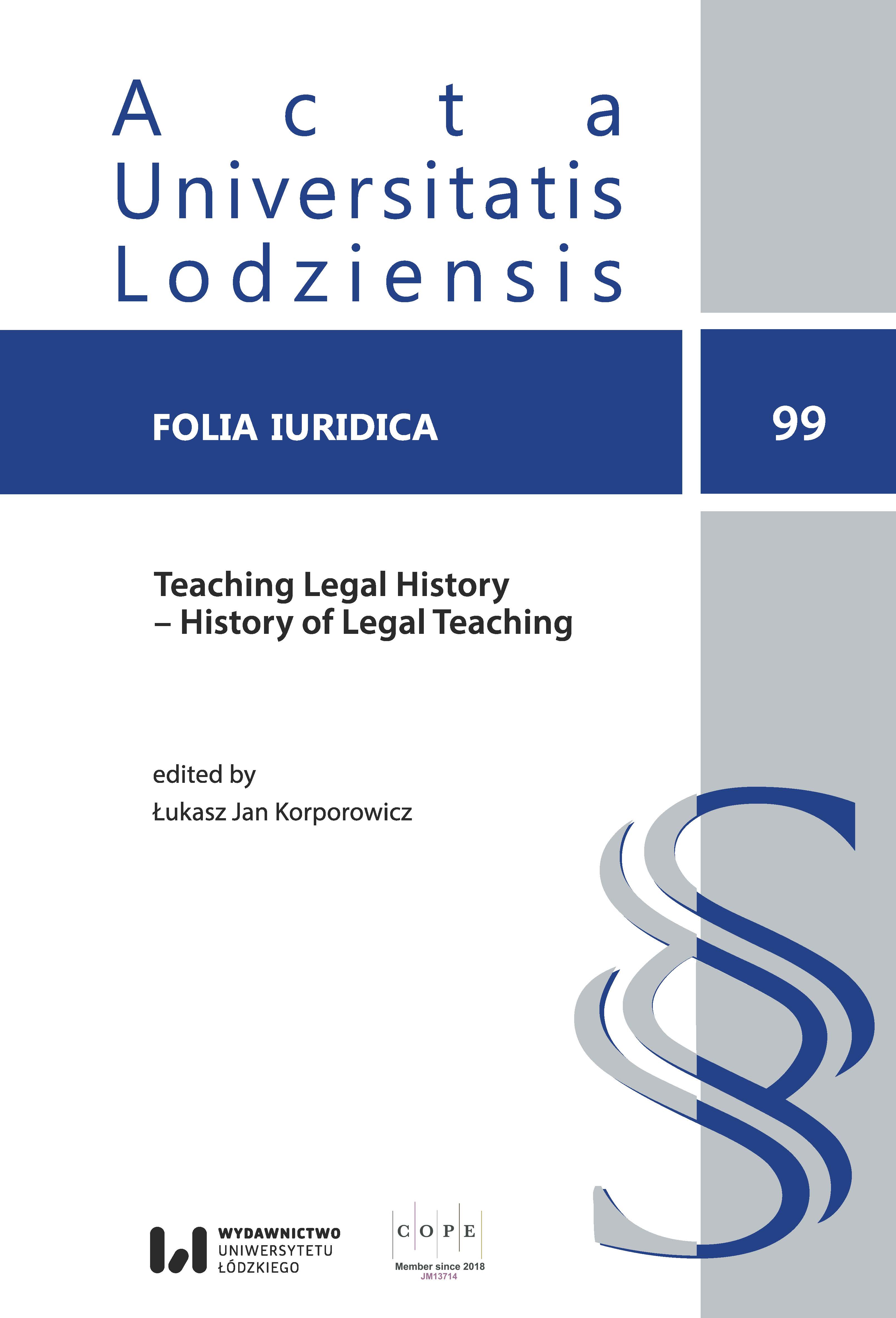Is iniuria autem occidere intellegitur, cuius dolo aut culpa id acciderit. Some Remarks on Gaius Teaching Tort Law
DOI:
https://doi.org/10.18778/0208-6069.99.08Keywords:
law of torts (Roman), illegality, fault, negligence, quasi-delict (Roman law)Abstract
When it comes to teaching law in the ancient world, the name Gaius spontaneously comes to mind. Gaius was a classical jurist who probably lived in a province in the east of the Roman Empire. Since he had no ius respondendi and thus was not entitled to deliver juristic opinions under the authority of the emperor, he devoted himself primarily to teaching law. His textbook of Institutes, which Barthold Niebuhr discovered in a library in Verona in 1816, gives us a good insight into the didactic skills of Gaius. Moreover, they allow us to see how legal teaching must have proceeded in the second century AD. This article deals with the presentation of tort law in the Institutes and puts the Institutes in the context of other writings by Gaius.
Downloads
References
Altmeppen, Holger. 2009. “Versari in re illicita.” In Festschrift für Rolf Knütel. Edited by Holger Altmeppen, Ingo Reichard, Martin Schermaier. 13–34. Heidelberg: C.F. Müller.
Google Scholar
Ankum, Hans. 2003. “L’édit du préteur de his qui deiecerint vel effuderint.” Studia Iuridica 41: 7–26.
Google Scholar
Cannata, Carlo Augusto. 1966. Richerche sulla responsabilità contrattuale nel diritto romano. Milano: Giuffrè.
Google Scholar
Cardilli, Riccardo. 1995. L’Obbligazione di “praestare” e la responsabilità contrattuale in diritto romano. Milano: Giuffrè.
Google Scholar
Cardilli, Riccardo. 2014. “Gestione empirica dell’imputazione e ‘culpae adnumeratio’ nella riflessione dei giuristi romani.” Index 42: 299–330.
Google Scholar
Gordon, William M., Olivia F. Robinson. 1988. The Institutes of Gaius. Translated with an Introduction. Ithaca (NY): Cornell University Press.
Google Scholar
Gröschler, Peter. 2002. Actiones in factum – Eine Untersuchung zur Klage-Neuschöpfung im nichtvertraglichen Bereich. Berlin: Duncker & Humblot.
Google Scholar
Jansen, Nils. 2003. Die Struktur des Haftungsrechts. Tübingen: Mohr Siebeck.
Google Scholar
Klausberger, Philipp. 2013. “Zur Actio de damno aut furto adversus nautas, caupones, stabularios.” In Fontes Iuris. Edited by Pierangelo Buongiorno, Sebastian Lohsse. 205–218. Napoli: Edizione Scientifiche Italiane.
Google Scholar
MacCormack, Geoffrey. 1971. “Culpa in eligendo.” Revue Internationale des Droits de l’Antiquité 18: 525–551.
Google Scholar
MacCormack, Geoffrey. 1974. “Aquilian Culpa.” In Daube Noster: Essays in Legal History for David Daube. Edited by Alan Watson. 201–224. Edinburgh–London: Scottish Academic Press.
Google Scholar
Mattioli, Fabiana. 2010. Ricerche sulla formazione della categoria dei cosidetti Quasi Delitti. Bologna: Bononia University Press.
Google Scholar
Nelson, Hein L.W., Ulrich Manthe. 2007. Gai Institutiones III 182–225: Die Deliktsobligationen. Text und Kommentar. Berlin: Duncker & Humblot. https://doi.org/10.3790/978-3-428-52508-9
Google Scholar
DOI: https://doi.org/10.3790/978-3-428-52508-9
Rundel, Tobias. 2005. Mandatum zwischen utilitas und amicitia. Perspektiven zur Mandatarhaftung im klassischen römischen Recht. Münster: LIT Verlag.
Google Scholar
Schipani, Sandro. 1969. Responsabilità “ex lege Aquilia”: criteri di imputazione e problema della “culpa.” Torino: Giappichelli.
Google Scholar
Scott, Samuel P. 1932. The Civil Law. Vol. VII. Cincinnati: The Central Trust Company.
Google Scholar
Tritremmel, David. 2020. “Vicarious Liability in Roman locatio conductio?” University of Vienna Law Review 4: 128–167.
Google Scholar
Watson, Alan. 1985. The Digest of Justinian. Latin Text edited by Theodor Mommsen with the aid of Paul Krüger. English translation edited by Alan Watson. Philadelphia (PY): University of Pennsilvania Press.
Google Scholar
Wicke, Hartmut. 2000. Respondeat Superior. Haftung für Verrichtungsgehilfen im römischen, römisch-holländischen, englischen und südafrikanischen Recht. Berlin: Duncker & Humblot. https://doi.org/10.3790/978-3-428-50139-7
Google Scholar
DOI: https://doi.org/10.3790/978-3-428-50139-7
Wittmann, Roland. 1972. Die Körperverletzung an Freien im klassischen römischen Recht. München: C.H. Beck.
Google Scholar
Wołodkiewicz, Witold. 1968. “Deiectum vel effusum e positum aut suspensum nel diritto romano.” Rivista Italiana per le Scienze Giuridiche 22: 365–391.
Google Scholar
Zimmermann, Reinhard. 1990. The Law of Obligations. Roman Foundations of the Civilian Tradition. Cape Town: Juta & Co.
Google Scholar
Zimmermann, Reinhard. 1992. “Effusum vel deiectum.” In Festschrift für Hermann Lange zum 70. Geburtstag am 24. Januar 1992. Edited by Dieter Medicus, Hans-Joachim Mertens, Knut Wolfgang Nörr, Wolfgang Zöllner. 301–330. Stuttgart–Berlin–Köln: Kohlhammer.
Google Scholar
Published
How to Cite
Issue
Section
License

This work is licensed under a Creative Commons Attribution-NonCommercial-NoDerivatives 4.0 International License.













